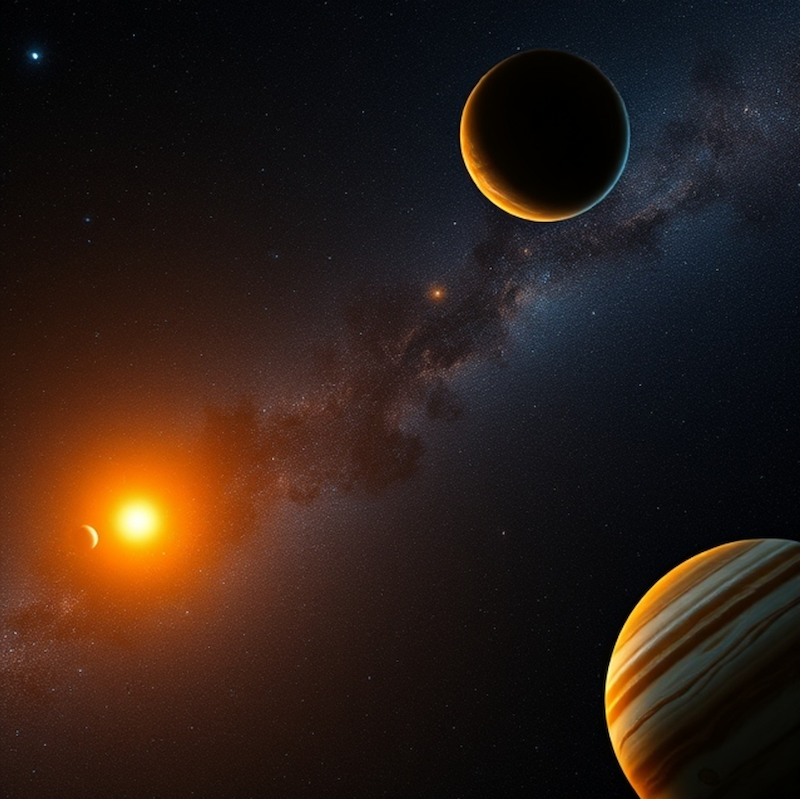
Violent dance of massive gas giant planets
13. 01. 2025
Astronomers have discovered a planetary system that exhibits the most intense gravitational interaction between two gas giant planets ever observed. This remarkable interaction is so strong that it causes apparent variations in the orbital periods of each planet on the order of days! The system, referred to as TOI-4504, also hosts a small sub-Neptune-sized planet, making it an essential piece of the puzzle for understanding the formation and evolution of planetary systems.
The planetary system TOI-4504, discovered by the Transiting Exoplanet Survey Satellite (TESS) mission in the southern constellation Carina, consists of two warm Jupiters and one mini-Neptune. Exoplanet TOI-4504 c has a mass of 3.8 Jupiter masses and orbits its star every 82 days in a way that the planet goes in front of its parent star and causes its dimming, so called transits. Its orbit is gravitationally affected by the non-transiting planet TOI-4504 d, which has a mass of 1.4 Jupiter masses. This interaction causes earlier or later passage of planet c in front of the star, thus variations in transit times. The amplitude of these changes is of about 4 days, marking the largest variation ever observed among known exoplanets. If planet d were a transiting planet, we would observe even larger variations of up to 6 days due to the gravitational influence of planet c.
The lead author of the study published in the Astrophysical Journal Letters was PhD student Michaela Vítková from AI CAS in the Czech Republic. "We were surprised to see such a large amplitude of the variations in the transit times of TOI-4504 c. The previous record holder had half this amplitude," says Vítková. The transit timing variations are particularly significant for planets in or near low-order resonant orbits, where the ratio of the planetary orbital periods is close to small integer values. This applies to TOI-4504 c and d, which have orbital periods close to a 2:1 ratio.
Both planets are categorized as warm Jupiters, which are crucial for understanding the history and evolution of planetary systems. "The investigation of the TOI-4504 system supports the scenario of a smooth migration into a resonant configuration during the protoplanetary disk phase," explains Trifon Trifonov from MPIA in Germany.
The study is based on photometric data from TESS satellite and spectra obtained with the FEROS spectrograph at a 2.2m telescope in Chile. In addition to planets c and d, there is a smaller planet with a mass of 10 Earth masses in an inner orbit, which has a period of 2.4 days. "The TOI-4504 system is quite complex, and gathering enough data for a reliable analysis takes time. Our study illustrates the benefits of a large collaboration," adds Rafael Brahm from UAI, Chile, the coordinator of the WINE consortium. "We can expect to discover even larger transit timing variations in the future," concludes Marek Skarka from AI CAS.
Link to the original paper: https://iopscience.iop.org/article/10.3847/2041-8213/ad9a53
DOI: 10.3847/2041-8213/ad9a53
Contact:
Michaela Vítková, main author
Astronomical Institute of CAS, Ondřejov, Czech republic
Masaryk University, Brno, Czech Republic
Email: vitkova@asu.cas.cz
Marek Skarka
Astronomical Institute of CAS, Ondřejov, Czech republic
Email: skarka@asu.cas.cz

Cartoon of the TOI-4504 system generated by DeepAI
Download the press release here.
Read also
- How lakes connect to groundwater critical for resilience to climate change
- A unique method of rare-earth recycling can strengthen the material independence
- High-energy cosmic rays dominated by heavy METALS
- Genome Tool Developed at CAS Featured in PLoS Genetics
- Why do brain cancer cells steal mitochondria?
- Secrets of the Nano- World: a new comic book about nanotechnology
- Teen duo from Slovakia and Czechia named Global Winner for clean water solution
- Professor Pavel Hozák Receives the Paul Nakane Prize
- Neutrino is lighter than previously thought
- The Earth Prize 2025 goes to Czechia and Slovakia for pioneering water purifier
Contacts for Media
Markéta Růžičková
Public Relations Manager
+420 777 970 812
Eliška Zvolánková
+420 739 535 007
Martina Spěváčková
+420 733 697 112